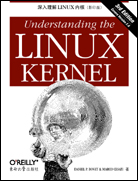
深入理解Linux内核(第三版,影印版)
出版时间:2006年04月
页数:923
为了彻底理解是什么使得Linux能正常运行以及其为何能在各种不同的系统中运行良好,你需要深入研究内核最本质的部分。内核处理CPU与外界间的所有交互,并且决定哪些程序将以什么顺序共享处理器时间。它如此有效地管理有限的内存,以至成百上千的进程能高效地共享系统。它熟练地统筹数据传输,这样CPU不用为等待速度相对较慢的硬盘而消耗比正常耗时更长的时间。
《深入理解Linux内核,第三版》指导你对内核中使用的最重要的数据结构、算法和程序设计诀窍进行一次遍历。通过对表面特性的探究,作者给那些想知道自己机器工作原理的人提供了颇有价值的见解。书中讨论了Intel特有的重要性质。相关的代码片段被逐行剖析。然而,本书涵盖的不仅仅是代码的功能,它解释了Linux以自己的方式工作的理论基础。
本书新版涵盖2.6版本,其在内核的几乎每个子系统中都有重要的变化,尤其是在内存管理和块设备领域。本书侧重于以下主题:
●内存管理,包括文件缓存、进程交换和直接内存存取(DMA)
●虚拟文件系统层和第二、第三扩展文件系统
●进程创建和调度
●信号、中断和设备驱动程序的主要接口
●定时
●内核中的同步
●进程间通信(IPC)
●程序的执行
《深入理解Linux内核》将使你了解Linux的所有内部工作,它不仅仅是一个理论上的练习。你将学习到哪些情况下Linux性能最佳,并且你将看到,在大量的不同环境里进行进程调度、文件存取和内存管理时它如何满足提供良好的系统响应的需要。这本书将帮助你充分利用Linux系统。
《深入理解Linux内核,第三版》指导你对内核中使用的最重要的数据结构、算法和程序设计诀窍进行一次遍历。通过对表面特性的探究,作者给那些想知道自己机器工作原理的人提供了颇有价值的见解。书中讨论了Intel特有的重要性质。相关的代码片段被逐行剖析。然而,本书涵盖的不仅仅是代码的功能,它解释了Linux以自己的方式工作的理论基础。
本书新版涵盖2.6版本,其在内核的几乎每个子系统中都有重要的变化,尤其是在内存管理和块设备领域。本书侧重于以下主题:
●内存管理,包括文件缓存、进程交换和直接内存存取(DMA)
●虚拟文件系统层和第二、第三扩展文件系统
●进程创建和调度
●信号、中断和设备驱动程序的主要接口
●定时
●内核中的同步
●进程间通信(IPC)
●程序的执行
《深入理解Linux内核》将使你了解Linux的所有内部工作,它不仅仅是一个理论上的练习。你将学习到哪些情况下Linux性能最佳,并且你将看到,在大量的不同环境里进行进程调度、文件存取和内存管理时它如何满足提供良好的系统响应的需要。这本书将帮助你充分利用Linux系统。
- Preface
- 1. Introduction
- Linux Versus Other Unix-Like Kernels
- Hardware Dependency
- Linux Versions
- Basic Operating System Concepts
- An Overview of the Unix Filesystem
- An Overview of Unix Kernels
- 2. Memory Addressing
- Memory Addresses
- Segmentation in Hardware
- Segmentation in Linux
- Paging in Hardware
- Paging in Linux
- 3. Processes
- Processes, Lightweight Processes, and Threads
- Process Descriptor
- Process Switch
- Creating Processes
- Destroying Processes
- 4. Interrupts and Exceptions
- The Role of Interrupt Signals
- Interrupts and Exceptions
- Nested Execution of Exception and Interrupt Handlers
- Initializing the Interrupt Descriptor Table
- Exception Handling
- Interrupt Handling
- Softirqs and Tasklets
- Work Queues
- Returning from Interrupts and Exceptions
- 5. Kernel Synchronization
- How the Kernel Services Requests
- Synchronization Primitives
- Synchronizing Accesses to Kernel Data Structures
- Examples of Race Condition Prevention
- 6. Timing Measurements
- Clock and Timer Circuits
- The Linux Timekeeping Architecture
- Updating the Time and Date
- Updating System Statistics
- Software Timers and Delay Functions
- System Calls Related to Timing Measurements
- 7. Process Scheduling
- Scheduling Policy
- The Scheduling Algorithm
- Data Structures Used by the Scheduler
- Functions Used by the Scheduler
- Runqueue Balancing in Multiprocessor Systems
- System Calls Related to Scheduling
- 8. Memory Management
- Page Frame Management
- Memory Area Management
- Noncontiguous Memory Area Management
- 9. Process Address Space
- The Process’s Address Space
- The Memory Descriptor
- Memory Regions
- Page Fault Exception Handler
- Creating and Deleting a Process Address Space
- Managing the Heap
- 10. System Calls
- POSIX APIs and System Calls
- System Call Handler and Service Routines
- Entering and Exiting a System Call
- Parameter Passing
- Kernel Wrapper Routines
- 11. Signals
- The Role of Signals
- Generating a Signal
- Delivering a Signal
- System Calls Related to Signal Handling
- 12. The Virtual Filesystem
- The Role of the Virtual Filesystem (VFS)
- VFS Data Structures
- Filesystem Types
- Filesystem Handling
- Pathname Lookup
- Implementations of VFS System Calls
- File Locking
- 13. I/O Architecture and Device Drivers
- I/O Architecture
- The Device Driver Model
- Device Files
- Device Drivers
- Character Device Drivers
- 14. Block Device Drivers
- Block Devices Handling
- The Generic Block Layer
- The I/O Scheduler
- Block Device Drivers
- Opening a Block Device File
- 15. The Page Cache
- The Page Cache
- Storing Blocks in the Page Cache
- Writing Dirty Pages to Disk
- The sync( ), fsync( ), and fdatasync() System Calls
- 16. Accessing Files
- Reading and Writing a File
- Memory Mapping
- Direct I/O Transfers
- Asynchronous I/O
- 17. Page Frame Reclaiming
- The Page Frame Reclaiming Algorithm
- Reverse Mapping
- Implementing the PFRA
- Swapping
- 18. The Ext2 and Ext3 Filesystems
- General Characteristics of Ext2
- Ext2 Disk Data Structures
- Ext2 Memory Data Structures
- Creating the Ext2 Filesystem
- Ext2 Methods
- Managing Ext2 Disk Space
- The Ext3 Filesystem
- 19. Process Communication
- Pipes
- FIFOs
- System V IPC
- POSIX Message Queues
- 20. Program Execution
- Executable Files
- Executable Formats
- Execution Domains
- The exec Functions
- A. System Startup
- B. Modules
- Bibliography
- Source Code Index
- Index
书名:深入理解Linux内核(第三版,影印版)
作者:Daniel P. Bovet, Marco Cesati 著
国内出版社:东南大学出版社
出版时间:2006年04月
页数:923
书号:7-5641-0276-4
原版书出版商:O'Reilly Media
购买选项